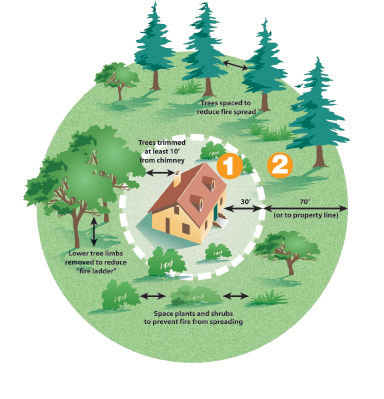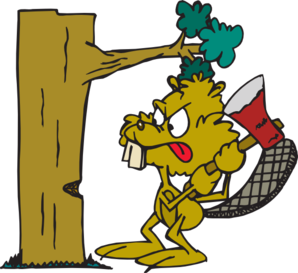Defensible Space & Mitigation Grants
From the Red, White & Blue Fire District
Protect Your Property
Homeowners can take a number of steps to protect their property and help alleviate the spread of wildland fires. Preventative measures include clearing excess fuel, creating defensible space around your home and using FireWise practices. Homeowners should be sensitive to the fact that fire is a natural part of our ecosystem.
Wildfire Defensible Zone
Due to Colorado’s arid climate and fire-dependent forests, many homeowners and landowners may be particularly vulnerable to wildfires. Fire is unpredictable and if there are weaknesses in your home’s fire protection plan, fire can gain the upper hand due to some overlooked or seemingly inconsequential factor. By creating a wildfire defensible zone, homes are less vulnerable from this naturally-occurring phenomenon and the chance of spreading wildfires is greatly reduced.
Ability to Survive Wildfires
2 factors have emerged as the primary determinants of a home’s ability to survive wildfires: choosing fire-resistant roofing material and creating a wildfire defensible zone. It is important to choose a fire-resistant roofing material that is rated Class C or higher when building a house in, or near, forests or grasslands. Avoid flammable materials such as wood or shake shingles.
Defensible Space
Defensible space is an area around a structure where fuels and vegetation are treated, cleared or reduced to slow the spread of wildfire toward the structure. It also reduces the chance of a structure fire moving from the building to the surrounding forest. Defensible space also provides room for firefighters to do their jobs. Your house is more likely to withstand a wildfire if grasses, brush, trees and other common forest fuels are managed to reduce a fire’s intensity.
Tips to Protect Your Home From Wildfire
- Actively manage your roof. Clean roof and gutters of pine needles and leaves at least twice a year to eliminate an ignition source for potential fires. This eliminates an ignition source for firebrands, especially during hot, dry weather.
- Beyond the initial 15 feet, thin trees to achieve 10-12 foot crown spacing. Occasionally, clumps of 2 or 3 trees are acceptable for a more natural appearance, if additional space surrounds them.
- Create defensible space on flat ground a minimum of 75 feet around a home. Increase this diameter if the structure is located on a slope.
- Dispose of all slash and debris left from thinning by either chipping, hauling away or piling and burning. Contact your local fire department or local Colorado State Forest Service forester for burning restrictions and/or assistance.
- Mow grasses and weeds to a height of 6 inches or less for a distance of 30 feet from all structures.
- Place liquefied petroleum gas (LPG) containers at least 30 feet from structures. Clear anything flammable, including vegetation, from within 10 feet of all tanks.
- Prune tree branches within the defensible space up to a height of 10 feet above ground.
- Remove shrubs and small trees or other potential ladder fuels from beneath large trees. Left in place, these fuels can carry a ground fire into tree crowns.
- Remove unhealthy vegetation. Trees and shrubs that are stressed, diseased, dead or dying should be removed so that they do not become a fuel source for potential fires.
- Stack firewood away from your house. Locate firewood at least 15 feet uphill from your home. Do not stack firewood under the deck.
- Thin out continuous tree and brush (shrub) cover around structures. Remove flammable vegetation from within the initial 15 feet around structures.
- Trim any branches extending over roofs, and remove branches within 15 feet of chimneys.
Additional resources and tips may be found here: Protect Your Home & Property from Wildfire | Colorado State Forest Service | Colorado State University (colostate.edu)
Defensible Space Zone

Defensible Space Grants 2026
Since 2011, the Town of Blue River has partnered with local foresters and the Summit County Wildfire Council Grant Program to encourage residents to conduct defensible space mitigation around their homes. Since 2011, over 100 homes have participated in the program. This year, we are hoping to increase the participation as we work to create strong defensible space within the Town of Blue River.
2026 Grant applications are now open. Homeowners are encouraged to contact the contractor of their choice to have an evaluation and bid conducted. The grant program will work the same regardless of which contractor you use. The project is a 50/50 grant. The Town also kicks in a $100 incentive for anyone that participate.
Example:
Total Cost of Mitigation: $12,000
50/50 Grant: -$6,000
Town Incentive -$100
Total Homeowner Bill: $5,900

Who Do I Contact to Apply?
To apply and receive a bid to participate in this year's grant program, contact one of the following contractors listed below.
Beetle Kill Tree Guys
(970) 485-3632
___________________________________
Ceres Landscaping
(970) 331-2853
___________________________________
Layman Tree Service
970-331-0790
___________________________________
TSH Tree Service
970-485-4969

